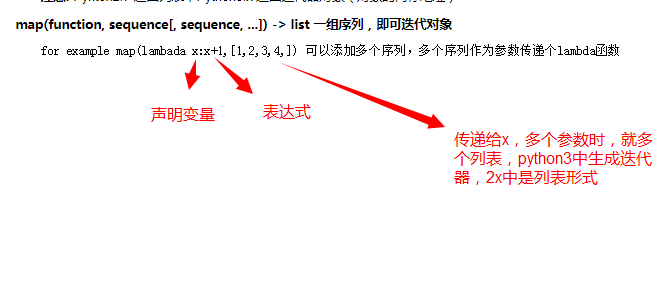python函数
filter() 函数用于过滤序列,过滤掉不符合条件的元素,返回由符合条件元素组成的新列表。
该接收两个参数,第一个为函数,第二个为序列,序列的每个元素作为参数传递给函数进行判,然后返回 True 或 False,最后将返回 True 的元素放到新列表中
注意: Pyhton2.7 返回列表,Python3.x 返回迭代器对象(对象的内存地址)
map(function, sequence[, sequence, ...]) -> list 一组序列,即可迭代对象
for example map(lambada x:x+1,[1,2,3,4,]) 可以添加多个序列,多个序列作为参数传递个lambda函数
enumerate() 内置函数用于将一个可遍历的数据对象(如列表、元组或字符串)组合为一个索引序列,同时列出数据和数据下标,一般用在 for 循环当中
>>>seasons = ['Spring', 'Summer', 'Fall', 'Winter'] >>> list(enumerate(seasons)) 输出 [(0, 'Spring'), (1, 'Summer'), (2, 'Fall'), (3, 'Winter')] >>>seq = ['one', 'two', 'three'] >>> for i, element in enumerate(seq): ... print i, element ... 0 one 1 two 2 three
format(*args,**kwargs)
Python2.6 开始,新增了一种格式化字符串的函数 str.format(),它增强了字符串格式化的功能。
基本语法是通过 {} 和 : 来代替以前的 %(详见http://www.runoob.com/python/att-string-format.html)

print("网站名:{name}, 地址 {url}".format(name="菜鸟教程", url="www.runoob.com")) # 通过字典设置参数 site = {"name": "菜鸟教程", "url": "www.runoob.com"} print("网站名:{name}, 地址 {url}".format(**site)) # 通过列表索引设置参数 my_list = ['菜鸟教程', 'www.runoob.com'] print("网站名:{0[0]}, 地址 {0[1]}".format(my_list)) # "0" 是必须的

>>>"{} {}".format("hello", "world") # 不设置指定位置,按默认顺序 'hello world' >>> "{0} {1}".format("hello", "world") # 设置指定位置 'hello world' >>> "{1} {0} {1}".format("hello", "world") # 设置指定位置 'world hello world'

也可以传入实例化对象 class AssignValue(object): def __init__(self, value): self.value = value my_value = AssignValue(6) print('value 为: {0.value}'.format(my_value)) # "0" 是可选的
对一个数据进行去重并按照原来的排序
list1 = [11,23,45,34,11,45] #先去重 ret = set(list1) #排序 ret1 = soted(ret,key=list1.index) //key是排序规则,默认是值得大小
补充:sys.stdout.flush() #刷新缓存(数据过小时(缓存为写满),subprocess等管道拿不到缓存的内容)
Take a small step every day




